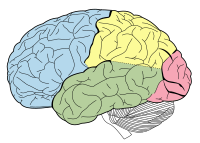
Photo from wikipedia
OBJECTIVES The aim of this study was to evaluate the efficacy of endoscope-controlled sinus floor augmentation through a mini-lateral window, compared with traditional lateral window approach. MATERIALS AND METHODS This… Click to show full abstract
OBJECTIVES The aim of this study was to evaluate the efficacy of endoscope-controlled sinus floor augmentation through a mini-lateral window, compared with traditional lateral window approach. MATERIALS AND METHODS This retrospective research included 19 patients and 20 augmented sinuses using lateral window approach with simultaneous implant placement (test group: a 3-4 mm round osteotomy; control group: a 10 × 8 mm rectangular osteotomy). Preoperatively (T0), immediately after surgery (T1), and 6 months postoperatively (T2), cone-beam computed tomography (CBCT) scans were obtained. Residual bone height (RBH), lateral window dimension (LWD), endo-sinus bone gain (ESBG), apical bone height (ABH), and bone density were measured. Intraoperative and postoperative complications were recorded. Patients' evaluation of pain first day after surgery and a week later was assessed by visual analog scale (VAS). RESULTS No significant difference was found in ESBG, ABH between the two groups at T1, T2 or their changes from T1 to T2. However, the increase of bone density value in the test group was significantly higher than control group (356.28 ± 149.59 vs. 242.99 ± 129.54; p < 0.05). The sinus perforation rate of test and control group was 10% and 20%, respectively. The VAS score of the test group at the first day after surgery was significantly lower than control group (4.20 ± 1.03 vs. 5.60 ± 1.71; p < 0.05). CONCLUSIONS Endoscope-controlled maxillary sinus floor augmentation through a mini-lateral window yield similar result with traditional approach in terms of bone height gain. The modified approach could facilitate new bone formation, reducing sinus perforation rate and postoperative pain.
Journal Title: Clinical implant dentistry and related research
Year Published: 2023
Link to full text (if available)
Share on Social Media: Sign Up to like & get
recommendations!